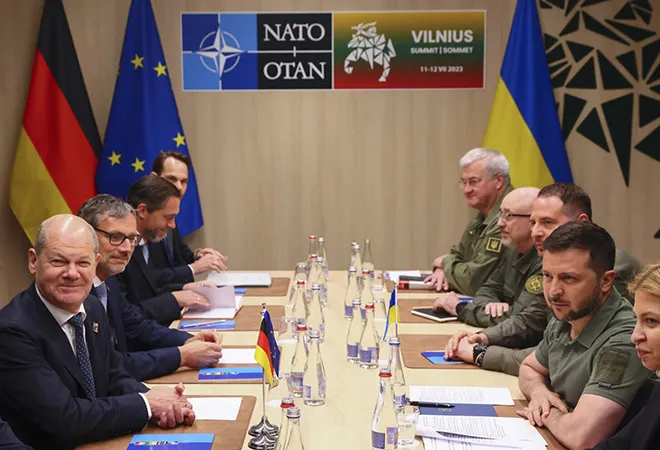-
CENTRES
Progammes & Centres
Location
The Vilnius Summit appears to be a transit point to more consequential future decisions even as it is unclear what security guarantees the G7 will provide to Ukraine

During the recent North Atlantic Treaty Organisation (NATO) summit in Vilnius on 11-12 July, all eyes were on the Alliance’s Ukraine dilemma. While other consequential issues also featured on the agenda—Sweden’s accession and the strengthening of NATO’s military footprint along its eastern flank—media coverage of the summit focused primarily on whether Kyiv would get any clarity regarding its aspirations to join NATO. The Ukrainian leadership made the issue their utmost priority, arguing that Kyiv’s NATO membership would provide for the long-term security of both Ukraine and the entire European continent. Therefore, they wanted the summit to specify an accession roadmap.
However, several key NATO members, including the United States (US) and Germany, remain opposed to offering Ukraine any clarity as to when it can become a part of the Alliance, and are not for greenlighting its accession now, especially when the Russia-Ukraine conflict appears to have no end in sight. The latter would amount to NATO entering a war with Russia (as per Article 5 of the North Atlantic Treaty). Promising membership once the war is over—what Kyiv was trying to secure—appears less problematic on the surface but still carries numerous risks. If anything, such a promise would create an incentive for Moscow to ensure that the war never ends. Moreover, it puts unprecedented stress on the credibility of Article 5 of the North Atlantic Treaty—the cornerstone of NATO’s collective defence, which for over seven decades has served the Alliance well as the ultimate deterrent against external aggression.
The Ukrainian leadership made the issue their utmost priority, arguing that Kyiv’s NATO membership would provide for the long-term security of both Ukraine and the entire European continent.
Thus, Kyiv’s maximalist goal for the summit was a mission impossible. It is, therefore, surprising that President Zelenskyy still thought he could pressure the Euro-Atlantic leaders by issuing a last-minute tweet saying it was, “absurd when timeframe is not set neither for the invitation nor for Ukraine’s membership”. As a result, he only angered his major partners and created unnecessary tensions during the summit. In all probability, after this failed pressure attempt in Vilnius, the Ukrainian government will find it increasingly difficult to continue extracting concessions from Western partners through media pressure campaigns, which it has done with impressive success since the conflict’s outbreak.
Instead of a clarified pathway to Ukraine’s membership, the summit communiqué concluded that NATO “will be in a position to extend an invitation to Ukraine to join the Alliance when Allies agree and conditions are met”. In essence, the wording equals to the formula adopted at the 2008 Bucharest Summit, which promised that one day Ukraine (and Georgia) “
Yet, the Zelenskyy government did not return from Vilnius empty-handed. The summit produced a three-component package for Ukraine.
The Council represents a more advanced forum, as its procedures will facilitate multilateral meetings “between equals”, i.e Ukraine will have the same rights in the Council as each NATO member state and will be able to convene its meetings.
First, when Allies “agree” it is time for Kyiv to embark on the accession process, it will no longer need to go through the so-called Membership Action Plan (MAP) stage that has traditionally been required from candidate countries. Finland and Sweden were also relieved of it. In the words of NATO Secretary General, Jens Stoltenberg, this “will change Ukraine’s membership path from a two-step process to a one-step process”. However, if the accession procedure were primarily of a bureaucratic nature, the decision would be a significant step forward for Kyiv. But the Vilnius Summit has evidently demonstrated that, like during the Cold War, it is now again purely political; hence, the abolition of the MAP stage per se does not really mean much for Ukraine’s prospects in NATO.
Second, the Ukraine-NATO Council was launched in Vilnius. Before, Kyiv’s cooperation with the Alliance was directed by a different body—the NATO-Ukraine Commission. The Council represents a more advanced forum, as its procedures will facilitate multilateral meetings “between equals”, i.e Ukraine will have the same rights in the Council as each NATO member state and will be able to convene its meetings. A parallel could be made between this new possibility that Ukraine has gained and Article 4 of the North Atlantic Treaty, which stipulates that “The Parties will consult together whenever, in the opinion of any of them, the territorial integrity, political independence or security of any of the Parties is threatened”. Yet, the scope and magnitude of decisions that the NATO-Ukraine Council can take are not comparable to those of the North Atlantic Council, where the member states meet. In a way, the Council will complement the existing Ukraine Defence Contact Group (Ramstein format), which has coordinated Western military assistance for Ukraine since April 2022.
Kyiv hoped for a somewhat stronger legal foundation—an international conference was supposed to adopt a multilateral agreement, not a declaration, to be later complemented with bilateral agreements.
To present the Council’s inception as a political victory, President Zelenskyy emphasises that it is an instrument of integration, which will help Ukraine to progress towards full membership of NATO. However, the Alliance appears to have a somewhat different reading, as it officially refers to the Council as a “forum for crisis consultations and decision-making”. Interestingly, in 2002, at the height of the rapprochement between Moscow and the West, the same format—the NATO-Russia Council—was launched as “a mechanism for consultation, consensus-building, cooperation, joint decision making, and joint action”.
The so-called “security guarantees” represent the third component of the package. Even though they were announced in Vilnius, the “guarantees” are offered by the G7 nations outside the NATO framework. The respective declaration promises “specific, bilateral, long-term commitments and arrangements”, which are to fill the generically-worded multilateral composition with substance. The signatories urge other nations to also join the scheme.
The idea underpinning the model is not new. It was first discussed during the Ukrainian-Russian talks in Istanbul on 29 March 2022. Back then, however, Kyiv hoped for a somewhat stronger legal foundation—an international conference was supposed to adopt a multilateral agreement, not a declaration, to be later complemented with bilateral agreements. Both agreements would require ratification by respective national legislatures. Later, the model featured in the Kyiv Security Compact, a proposal by a group of Western experts co-chaired by Andriy Yermak, the Head of the Presidential Office of Ukraine, and former NATO Secretary General Anders Fogh Rasmussen.
Prior to the Vilnius Summit, President Biden stated that Washington’s guarantees can become operational only after Ukraine and Russia reach a ceasefire agreement.
In a nutshell, what both the Kyiv Security Compact and the G7 declaration mean by security commitments is, “arming Ukraine to the teeth”. Essentially, this amounts to the status quo and is rather about military and financial assistance than decent security guarantees—in fact, the G7 declaration does not use the term “security guarantee” even once. What might be the declaration’s added value is an intended signal that the signatories commit to the long-term support of Ukraine. According to Western diplomats, the framework is, “meant to outlast election cycles in participating states”. In other words, this is an attempt to ensure that even if a Ukraine-sceptic government assumes office in a G7 state (e.g. Trump returns to the White House in 2024) or public moods in respective societies change unfavourably for Kyiv, the committed assistance will nonetheless continue to flow.
However, this ambition remains declaratory as long as no implementation mechanism has specified how exactly the multilateral-bilateral mix will work. Even with the stated goal of outlasting election cycles, it is hard to imagine how the commitments could be inoculated against likely elite and public opinion volatility. The only way of doing so would be to ensure that large majorities in the national parliaments are required to amend and/or revoke the bilateral arrangements, but this looks rather unrealistic now.
Other questions about the feasibility of the arrangement also persist. For example, as the multilateral framework appears to lack a unified set of parameters and everything will be decided bilaterally, can such a polyphony of security commitments work as a single mechanism? And what happens to the overall framework if one or more guarantors backtrack for some reason? Moreover, it remains unclear when exactly the guarantees mechanism will get activated: Already right now, after the conflict ends, or in case of a future aggression against Ukraine? The declaration and statements by G7 leaders look rather misleading here. For instance, prior to the Vilnius Summit, President Biden stated that Washington’s guarantees can become operational only after Ukraine and Russia reach a ceasefire agreement. Whether it is the official position or just something Biden said in an interview makes a sizeable difference.
Until these and other questions are answered, we can’t understand the real value of what the West is ready to offer to Ukraine. Obviously, the answers will depend on further developments on the Ukrainian battleground and, more broadly, in global security. In that respect, the Vilnius Summit was just a transit point to more consequential future decisions.
Yauheni Preiherman is the founder and director at the Minsk Dialogue Council on International Relations (Belarus).
The views expressed above belong to the author(s). ORF research and analyses now available on Telegram! Click here to access our curated content — blogs, longforms and interviews.

Dr Yauheni Preiherman is the founder and director at the MinskDialogue Council on International Relations (Belarus). He holds a Ph.D. in Politics and International Studies ...
Read More +